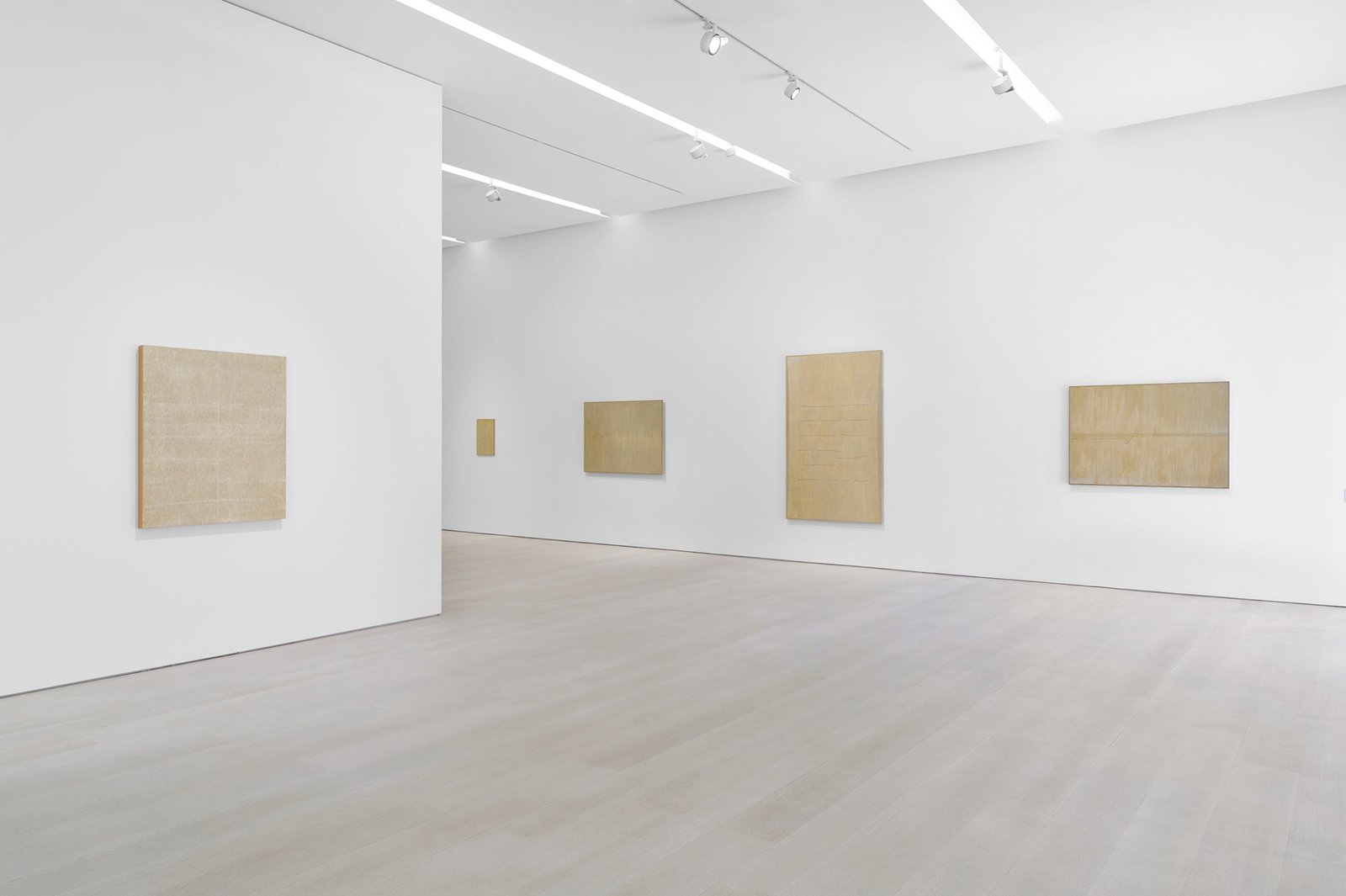On View
Pace Gallery
TRANSCENDENCE
May 3–August 16, 2024
New York
Of the twenty-four paintings in Huong Dodinh’s TRANSCENDENCE, the Vietnamese French artist’s first solo show in New York, twenty-three fall under the broad mandate of abstraction—subtle experiments in line and light that coalesce towards a meditative mutability. The craggy expressionism of her “Sans titre” (1989–94) series, biomorphic forms on sepia-toned landscapes, yields to a sparer topography of short, disjointed lines in Présence 9 and T 2 (both 1992)—a style that is further pared back in works like N.H.N 1 and N.H.N 2 (both 2023) to achieve the near-monochromatic serenity of Dodinh’s later period.
The outlier among this stylistic progression is La Neige (1966), painted when Dodinh was twenty-one, making it the oldest work in the exhibition. La Neige depicts a snow-covered neighborhood from a lofty distance, perhaps from the perspective of a bird or a low-flying plane. Two pedestrians and their dog appear in miniature, walking down a snowy path. The frozen lake in the background recalls one of Monet’s winter landscapes; Dodinh’s preoccupation with light and use of pastels evince his inspiration on her work.
La Neige serves as a figurative prelude to the rest of the paintings. Its domestic tranquility almost deflects from the transformative wonder that such a scene stirs in Dodinh, who speaks reverentially about witnessing her first snowfall. “When the snow started to melt, it revealed the subtleties of everything beneath it,” Dodinh said of the “miracle” that altered her perception of color, nature, and light.1 From this revelation, painting became a “pursuit of clarity,” a practice she has quietly sustained for nearly six decades in Paris.
Dodinh did not have gallery representation before joining Pace in 2022, and her works were rarely ever shown. Her first solo gallery show, VIE | VIDE, was presented last summer in Seoul—a fitting location, as Dodinh’s methods of composition are similar to painters affiliated with Korea’s Dansaekhwa school, the post-war monochrome movement. Their method is akin to Dodinh’s own fixation on process—of making her own pigments and organic binders and the repetitious, rigorous application of thin paint—over aesthetics.
In TRANSCENDENCE, formal clarity is conveyed through effacement. Dodinh returns to the simplest of geometric forms (lines, squares, circles) to achieve her desired effect, rendering the canvas into a totalizing void. She describes the void as the epitome of tranquility, a spiritual state to be imparted through painting. But in spite of these lofty aims, some of her most restrained works are as sedate as they are stately. The desaturated blues in X. K. 1 (2024) blanch the composition of its lively essence and absorb the potent force of the vertical white lines running through its center. In H3, H5, H6, and H7 (all 1994), two perpendicular white lines, resembling an x- and y-axis, are embossed on a white canvas—a coordinate plane populated by haphazard line-fragments, plotted by some impossible mathematical formula. The lines don’t float in space with the spirited ease of the markings in Sans Titre (1992). Rather, they are rugged and dense, stiffly imprinted upon the canvas by many layers of paint.
And while N.H.N 1 and N.H.N 2 share this pallid palette, the paintings are redeemed by a delicate interplay of color, allowing the viewer to revel in the diaphanous mutability of neighboring tints: a grayish blue mutates into a greenish yellow into a purplish red. From afar, the distinct squares form a grid that is capable of holding and reflecting light, presenting us with the gauzy gradations of color. The effect is soft, subdued, and deceptively natural, as if the squares have organized themselves according to this hidden order.
Dodinh’s most compelling abstractions indulge in this astonishing fluidity of form and color. In K.A.145, December 2011 – January 2012 (2011–12), which recalls Agnes Martin’s “Innocent Love” series (1999), a pale pink rectangle sits between two gray-white bands. A red and yellow line diagonally cuts through the foreground, like a descending graph. The stark presence of the line does not disrupt the serenity of the scene, but amplifies its surface, like how the glint of the sun, reflecting against a body of water, can cut through one’s field of vision.
The raindrop-like splotches of taupe in Sans titre (1994) achieve a similarly naturalistic effect, albeit by blurring any notion of foreground and background into the canvas’s mottled skin. The painting contains a vague white outline of a coordinate plane at its center, but the lines blend into the textured taupe. It mimics how our eyes might look at a rain-streaked window with the flecks on the window pane as a visual filter obscuring the blurred landscape beyond. Sans titre (1994) invites the eye to wander, and I kept returning to it as I circled the gallery, surprised each time by a new detail I’d uncovered.
The earlier canvases are not to be overlooked, but their harsh shadows and rough-hewn outlines lack the refined airiness of Dodinh’s mature works with their acute balance of light and color—a visual effect impossible to accurately capture on camera. The paintings in TRANSCENDENCE require patience from the viewer to observe how light moves through the faint washes of blue, brown, and gray, and to yield to this heightened, private dimension of sense unfolding before you.
- “Huong Dodinh: Revealing Light,” Pace Gallery, April 26, 2024. https://www.youtube.com/watch?v=_Luup5mIcCc.









